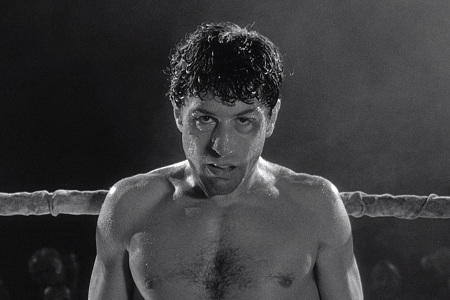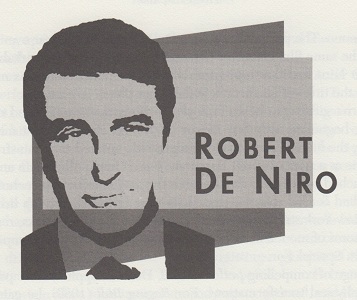Born: August 17, 1943, New York, NY
I had to decide early on whether I was to be an actor or a personality.
—Robert De Niro
Editor’s note: The essays of Scott Smith’s 1998 book, The Film 100, are being republished in their entirety here on Keyframe, not so much as the last word on cinema, but as a starting point for further discussion. Please join the conversation. To view the entire Film 100 list and find links to all the essays, please visit Reintroducing the Film 100.
Robert De Niro is perhaps the finest character actor of his generation, a modern-day Fredric March, handsome enough to play the leading man and plain enough to disappear into roles with just the slightest disguise. He brought authenticity to the screen in the sweeping movement towards realism in films of the 1970s, primarily in roles that examined the darker recesses of the human psyche. Hundreds of movie actors have made obvious attempts to match his intensity, but few are able to exude the subtle complexities that have characterized his performances.
De Niro dropped out of high school in 1960 to pursue a career on Broadway. Joining the Actors Studio, he studied method acting under Marlon Brando’s legendary instructors, Stella Adler and Lee Strasberg. Brian De Palma gave De Niro one of his first chances to showcase his talents in The Wedding Party (1969) and recommended him for the part of Ma Barker’s drug addicted son in Roger Corman’s Bloody Mama (1970).
An award from the New York Film Critics drew attention to his moving performance as a dying baseball player in Bang the Drum Slowly (1973), and when they saw him in Mean Streets (1973), audiences knew they were watching someone special. Following Francis Ford Coppola’s The Godfather Part II (1974), De Niro was called “the New Brando,” having gracefully re-created many of the subtle behaviors that Marlon Brando had originated for Don Vito Corleone. The performance gave De Niro the first Oscar ever awarded twice to the same film character (Brando won it in 1972). Remarkably, at age thirty, De Niro had developed into a counter-culture hero; his name was placed in the titles of hit records and foreign films.
De Niro’s gifts were best employed in films that emphasized character over plot, beginning with Taxi Driver (1976). As cinema’s most memorable psychotic, the haunted and tragic Travis Bickle entered the mainstream cultural fabric as a symbol of our desperate search for fulfillment in an increasingly detached society. In what became the trademark of his technique, De Niro studied for his role: he passed the test for a cab driver’s license and cruised New York streets in twelve-hour shifts for several weeks, researched the symptoms of mental illness and investigated the rituals and superstitions of Vietnam Special Forces veterans.
In a range of compelling performances, De Niro applied more psychological and physical transformations. For Raging Bull (1980), he gained sixty pounds to play the faded boxer Jake LaMotta in scenes that represented only minutes of the entire film, and during a sparring session with Joe Pesci, he got lost in the moment and accidentally broke the costar’s rib. For the role of Max Cady in Cape Fear (1991), De Niro paid an oral surgeon $25,000 to have his teeth temporarily altered to appear ill-tended; he also stained his skin for months with vegetable dye to simulate the look of real tattoos.
These credible transformations characterized the gritty “street” feel in the films of Martin Scorsese, the director with whom De Niro has collaborated more often than with any other. In fact, the success of Scorsese’s films is mostly due to De Niro’s willingness to immerse himself completely in each role and to go to extreme lengths to understand his characters. Furthermore, securing De Niro as a star in a film was often crucial to the financing of Scorsese’s films. In all, they have made eight films together, with a scheduling delay preventing a ninth—De Niro was originally to play Jesus in Scorsese’s The Last Temptation of Christ (1988). It is almost inconceivable to suggest another actor who would have lent the same level of veracity to this body of work, and no other actor has made such an indelible mark on the career of a director since John Wayne last appeared in a John Ford western.
De Niro’s depiction of a returning Vietnam War veteran in The Deer Hunter (1978) sparked a controversy that cost him the Oscar he deserved in 1978. After Universal Pictures had already spent nearly $250,000 on their Best Actor campaign, there was a backlash from veterans’ groups objecting to the suggestion that vets were uncommunicative loners on the brink of committing violent acts. Jon Voight, who played a more appealing vet in Coming Home (1978), won the statue. Ironically, Deer Hunter garnered awards for director Michael Cimino and the supporting performance of Christopher Walken. In fact, many insiders felt that De Niro’s allegiance to New York filmmaking upset Hollywood loyalists in the Academy and was more responsible than the veterans’ groups for his loss.
His tour de force in Raging Bull did bring him the Best Actor Oscar, and strong performances in True Confessions (1981), Once Upon a Time in America (1984) and The Mission (1986) placed him among the most respected actors of his generation. Cashing in on his ability to produce respectable grosses, De Niro took less challenging roles throughout the eighties and nineties to finance his own New York-based film production company, but his reputation has suffered little over the years.
With his gift of rendering reprehensible antagonists human and complex, De Niro has remained one of the most watchable men in movie history. Critics continue to regard him as a creator of powerful screen characters, and fans are drawn to his films in the hopes of getting a glimpse of the private personality behind the characters. Like Brando before him, Robert De Niro’s naturalistic style often feels immediate and improvisational, and his effect on younger actors is reflected in the smoldering intensity and explosiveness of Sean Penn, Johnny Depp, Mickey Rourke, Gary Oldman, Eric Roberts, Michael Madsen and scores of others.
To read all the republished articles from ‘The Film 100,’ go to Reintroducing the Film 100 here on Keyframe.





